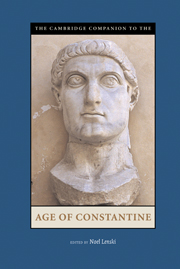Book contents
- Frontmatter
- Introduction
- 1 Sources for the History of Constantine
- Section 1 Politics and Personalities
- 2 Before Constantine
- 3 The Reign of Constantine
- 4 The Dynasty of Constantine Down to 363
- Section II Religion and Spiritual Life
- Section III Law and Society
- Section IV Art and Culture
- Section V Empire and Beyond
- Appendix 1: Stemmata
- Appendix 2: Timeline
- Maps
- Primary Sources and Translations
- Secondary Bibliography
- Index
4 - The Dynasty of Constantine Down to 363
from Section 1 - Politics and Personalities
Published online by Cambridge University Press: 28 September 2007
- Frontmatter
- Introduction
- 1 Sources for the History of Constantine
- Section 1 Politics and Personalities
- 2 Before Constantine
- 3 The Reign of Constantine
- 4 The Dynasty of Constantine Down to 363
- Section II Religion and Spiritual Life
- Section III Law and Society
- Section IV Art and Culture
- Section V Empire and Beyond
- Appendix 1: Stemmata
- Appendix 2: Timeline
- Maps
- Primary Sources and Translations
- Secondary Bibliography
- Index
Summary
From the elevation of Constantius I as Caesar in 293 to the death of the emperor Julian in 363, the family of Constantine would play a direct and major role in the later Roman empire for seventy years. The actions of Constantius I’s first son, Constantine, would forever change the nature of the Roman empire and of Western civilization. In an effort to elucidate this impact, this chapter will begin by examining the ways in which Constantine adopted and adapted the Tetrarchic system established by Diocletian into a family dynasty. It will then investigate how this plan was followed - and sometimes not - in the period after Constantine’s death up to the death of his nephew Julian, the last male dynast to rule as emperor. As we shall see, however, the next dynasty, the house of Valentinian, established connections to the Constantinians through marriages to a granddaughter and, probably, a grandniece of Constantine, with the result that the bloodline of the family continued to run through the veins of Roman emperors well into the fifth century. The chapter ends with a quick look at the afterlife of the image of Constantine in the later Roman empire and in world history.
- Type
- Chapter
- Information
- The Cambridge Companion to the Age of Constantine , pp. 91 - 108Publisher: Cambridge University PressPrint publication year: 2005
- 27
- Cited by

